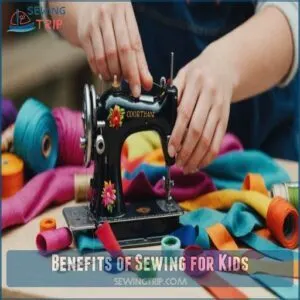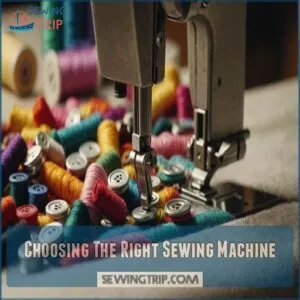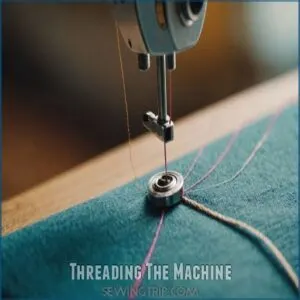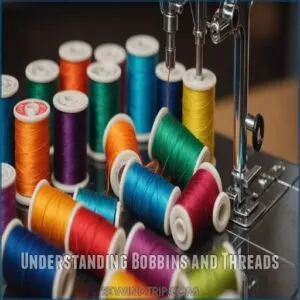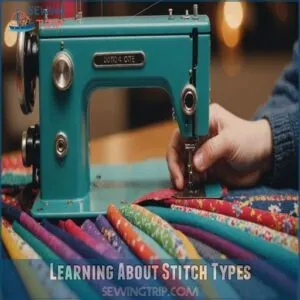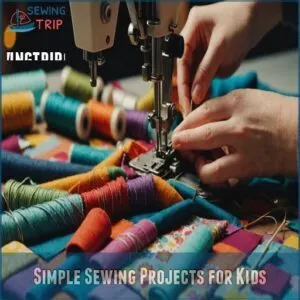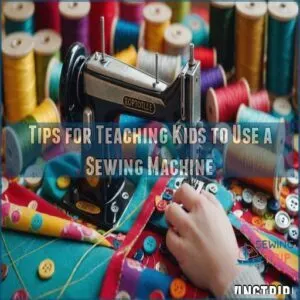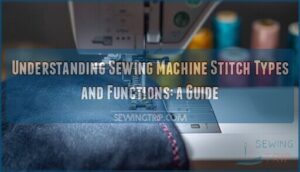This site is supported by our readers. We may earn a commission, at no cost to you, if you purchase through links.
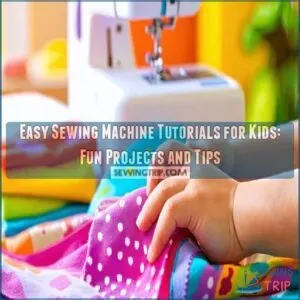 Teaching kids how to sew with a machine can be like threading a needle—challenging at first, but oh-so-rewarding.
Teaching kids how to sew with a machine can be like threading a needle—challenging at first, but oh-so-rewarding.
Easy sewing machine tutorials for kids open up a world of creativity and skill-building.
Start with simple projects like bookmarks and pillows, which are fun but also great for developing fine motor skills.
Make sure your child uses a kid-friendly sewing machine with safety features and easy controls.
Break down the tasks into manageable steps, and remember, patience makes practice perfect!
Before you know it, your child will be crafting show-stopping creations.
Ready to start this adventure together?
Table Of Contents
Key Takeaways
- Start with simple projects like bookmarks and pillows to develop fine motor skills while keeping it fun and engaging.
- Choose a kid-friendly sewing machine that emphasizes safety features and simplicity for easier sewing sessions.
- Break tasks into manageable steps to prevent overwhelming beginners and foster a sense of accomplishment with each completed project.
- Encourage creativity by allowing kids to select color palettes and design their own projects, nurturing their imagination and inventive spirit.
Benefits of Sewing for Kids
Sewing offers kids a fun way to develop important life skills like patience, creativity, and fine motor coordination—plus, you won’t mind them sewing their own missing buttons!
It’s a delightful activity that turns imagination into tangible, handmade treasures, encouraging them to create with their hands and minds engaged fully.
Developing Fine Motor Skills
Sewing’s a fun way to sharpen those fine motor skills!
By tackling sewing patterns, you’re giving your hand-eye coordination a workout.
Imagine the thrill of threading needles and mastering buttoning skills.
Pinching practice with fabric feels like a tiny adventure.
Each stitch you make builds dexterity and confidence, setting the stage for even trickier tasks down the line.
Boosting Creativity
Graduating from fine motor skills, let’s burst into creativity!
Watch your child’s imagination blossom as they choose color palettes, mix fabric textures, and craft unique design sketches.
Sewing offers a playground of project themes where kids express their inventive side.
Who knows, today’s wacky idea might be tomorrow’s masterpiece!
Encourage them to stitch their dreams into reality.
Nurturing Patience and Perseverance
How often do you find yourself getting frustrated with a tricky seam?
Sewing teaches patience; those tiny stitches add up!
Don’t sweat the small stuff—or the mistakes.
Learning from failure is key.
Set realistic goals; start with simple projects.
Troubleshooting is part of the fun!
Encouraging confidence builds with each finished project.
You’ll be amazed at what you can create with practice and perseverance.
Choosing The Right Sewing Machine
Picking the right sewing machine for your child can feel like choosing the perfect pet—something manageable, safe, and easy to care for.
Focus on size, weight, and safety features to make sure their sewing journey starts off on the right stitch.
Size And Weight
Kids love expressing creativity, and finding the right sewing machine can boost their skills!
Think about:
- Portable options that fit in any room
- Compact designs for easy storage solutions
- Weight that suits your child’s strength
- Clever space considerations for small areas
- Machines with a comfy, ergonomic design
By incorporating activities that spark their interest in sewing and letting them choose their own projects, kids can develop a strong foundation in sewing. These tips make sewing fun and manageable for kids!
Safety Features
Choosing a sewing machine with excellent safety features puts your mind at ease.
Look for needle guards and finger guards to protect curious fingers.
A foot pedal can help teach control, and don’t forget the basics like safety pins to avoid mishaps.
Clear safety instructions help everyone stay safe while having fun sewing!
| Feature | Benefit | Example |
|---|---|---|
| Needle Guards | Protect fingers | Janome 720 |
| Finger Guards | Prevent injuries | Singer 1304 |
| Foot Pedal | Teaches control | Brother CS600 |
| Safety Pins | Avoid accidents | Dritz Safety |
| Safety Instructions | Safety education | User Manual |
Ease Of Use
Let’s face it, not every sewing machine is a walk in the park.
After safety, you’ll want simplicity.
Opt for beginner-friendly machines with a user-friendly interface.
Simple stitch selection, such as using a stitch selector dial, and an easy threading process save both time and sanity.
Plus, kid-safe features are a big win.
Imagine your child stitching with ease—kind of like riding a bike, without the wobble!
Essential Sewing Machine Parts for Kids
Understanding your sewing machine’s essential parts, especially when introducing it to kids around the age of 6 as recommended by most sewing experts for safe sewing practices for kids, is like finding the secret ingredients to a favorite recipe—once you know them, everything else becomes easier.
You’ll get to thread the machine, figure out bobbins and threads, and eventually master different stitch types, all while having fun!
Threading The Machine
A small challenge awaits: threading the machine.
It’s like that tricky moment slipping a shoelace through a tight sneaker hole.
Start by threading the needle, ensuring it’s smooth sailing.
This is where a kids’ sewing machine can make things easier, as they often have simplified threading systems.
Watch the thread tension closely, like you’re tuning a guitar.
Choose your thread wisely to avoid troubleshooting jams later.
Patience here will make sewing feel like a breeze!
Understanding Bobbins and Threads
Two important parts of your sewing machine are the bobbin and the thread.
You’ll need to learn about bobbin types and how to wind a bobbin correctly.
Proper bobbin placement is key!
Experiment with different thread colors to personalize your projects.
Remember, the right thread tension makes all the difference—it’s like finding the sweet spot for a perfect stitch.
Have fun exploring!
Learning About Stitch Types
Imagine you’re discovering a treasure trove of stitch types—think basic stitches like the trusty straight stitch for seams and the playful zigzag stitch for stretch fabrics.
You can also learn about the Locking Stitch Guide to secure seams without backstitching, perfect for delicate fabrics.
These are your sewing machine’s superpowers!
And those decorative stitches? They’re like sprinkles on a cupcake, adding flair to any project.
Get started, experiment, and watch your creations come alive!
Simple Sewing Projects for Kids
You’re about to have tons of fun with easy sewing projects that spark creativity and teach useful skills.
From crafting colorful bookmarks and pincushions to sewing simple pillowcases and cuddly stuffed animals, these projects are perfect for kids just starting out.
Making Bookmarks and Pincushions
Exploring the sewing machine’s parts can help kids start with basic projects like the elastic-waist skirt, a simple and beginner-friendly project that involves sewing straight seams and attaching an elastic waistband as seen in simple sewing machine projects for beginners. Exploring the sewing machine’s parts opens up fun projects.
Who knew bookmarks and pincushions could be so cool?
Choose colorful fabric, follow simple sewing patterns, and add your personal flair with embellishments.
You can find a variety of kid-friendly sewing machines online at kids sewing machine.
Each stitch counts!
- Fabric choices: Go wild with patterns or keep it simple.
- Project ideas: Think space, flowers, or fancy script.
- Finishing touches: Add buttons or ribbons for pizzazz.
Creating Simple Pillowcases and Bags
Finished those bookmarks? Great! Let’s move on to creating simple pillowcases and bags.
These fun projects offer a chance to experiment with fabric choices and pattern ideas.
Start by selecting a vibrant fabric, then follow basic sewing techniques for assembly.
Add finishing touches like bows or buttons for a personal style.
These easy projects are perfect for practicing your sewing skills!
Designing and Sewing Stuffed Animals
When designing and sewing stuffed animals, start by choosing fabrics that scream fun.
Pattern ideas can be as simple as your imagination, turning sketches into cuddly friends.
Adding details like sewing eyes requires focus, but it’s a stitch in time.
Don’t forget stuffing techniques; they’re the fluff to your teddy’s bear.
Roll up your sleeves, and watch those creations come alive!
Tips for Teaching Kids to Use a Sewing Machine
Teaching kids to sew can be a fun adventure if you break tasks into small, easy steps and introduce quality tools, and keep your patience handy, just like a box of snacks.
Encourage them to keep practicing and remember, a little praise goes a long way in boosting their confidence.
Breaking Down Complex Steps
Learning to sew can feel overwhelming, but it’s easier than you think!
Break down each step into smaller, manageable chunks.
You could even find some inspiration for easy-to-follow patterns to get started.
Use visual aids like step-by-step photos; they’re lifesavers!
Simple language and clear instructions are key.
Remember, practice makes perfect, so don’t get discouraged if it doesn’t click immediately.
You got this!
Encouraging Practice and Patience
Getting a grip on sewing takes time, but don’t fret.
By introducing real tools for kids sewing, you’re ensuring your child’s safety but also teaching them the value of craftsmanship.
Set realistic goals and sprinkle in fun rewards to keep things lively.
Overcoming frustration is key, so remind them it’s normal to fumble with the thread.
Positive reinforcement builds confidence, making every small stitch a victory.
With patience, they’ll soon be crafting masterpieces—one stitch at a time!
Providing Positive Feedback and Support
Patience is key in every seam, but showering kids with positive feedback can supercharge their confidence.
Kids’ faces light up when their unique creations get genuine applause.
Remember, mistakes are part of learning, not a disaster. Encouragement nurtures motivation, turning sewing sessions into joyful adventures. So, keep the compliments flowing and watch them stitch with pride!
Frequently Asked Questions (FAQs)
How do I ensure sewing safety for kids?
Sewing safety’s like a superhero cape – it protects you! Always supervise young sewers, keep fingers away from needles, and use blunt-tipped needles for extra safety. Have fun, but be careful!
What age is appropriate to start sewing?
Starting at age 6, kids can begin learning sewing with supervision.
Every child is different, so gauge their interest and ability.
Keep it fun and simple, like threading a needle, before moving on to more complex projects.
Are there sewing machines designed specifically for children?
Ever wonder if there are handheld sewing machines designed specifically for young crafters, such as the best handheld sewing machine for kids, that can help them develop their sewing skills. Ever wonder if there are sewing machines for kids?
You’re in luck!
Yes, there are!
These machines come with safety features and simple controls, making it easy and fun for kids to learn sewing safely.
How do I maintain a childs sewing machine?
Keep your child’s sewing machine in tip-top shape by dusting it after each use.
Oil it according to the manual, and check the needle often.
Tighten loose screws, and cover the machine to keep it dust-free.
What are common sewing mistakes kids make?
Kids often sew wrong sides together, forget to backstitch, and use incorrect tension settings.
It’s like baking a cake and forgetting the sugar—lessons learned the fun way!
Patience and practice turn these hiccups into confident stitches.
Conclusion
Imagine the joy when your child feels confident at the sewing machine, thanks to these easy sewing machine tutorials for kids.
By choosing beginner-friendly projects, you’re not just teaching them a skill; you’re nurturing creativity, patience, and fine motor skills.
Each stitch is a step forward, echoing life’s own journey.
As they finish those charming pillowcases, or quirky stuffed animals, they’ll realize sewing is as fun as it’s rewarding.
Ready to start this stitching adventure?

